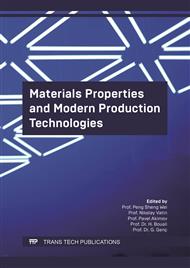p.73
p.79
p.87
p.93
p.101
p.107
p.113
p.121
p.129
Research on High-Temperature Constitutive Relationship of Aluminum Alloy
Abstract:
On the worldwide tendency of wight reduction of automobile, aluminum is drawing a large number of researcher’s sights because it’s advantages of low weight, corrosion resistance, flexible and so on. Aimed at understanding high-temperature flow behavior of aluminum alloy A5005, tensile tests were conducted at temperatures 360°C, 430°C, 500°C and strain rates 0.0003s-1, 0.003s-1, 0.03s-1 respectively. For constitutive equation molding, a simplified Johnson-Cook model was adopted to describe high-temperature relationship of A5005 alloy. One of superiorities of this model is the flow stress model can be established more efficiently. What’s more, adiabatic temperature rise is eliminated by introducing development trend of material stress and strain in this model. Finally, the root mean square error (RMSE) was used to check the accuracy of the final model. The results show that the model accuracy increase by temperature increasing and strain rate decreasing, and the simplified Johnson-Cook model can describe stress-strain tendency without losing much accuracy.
Info:
Periodical:
Pages:
101-106
Citation:
Online since:
July 2022
Price:
Сopyright:
© 2022 Trans Tech Publications Ltd. All Rights Reserved
Share:
Citation:



